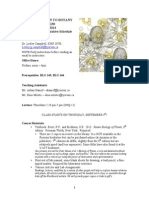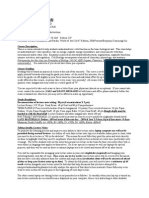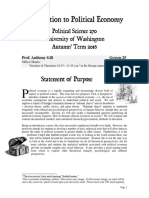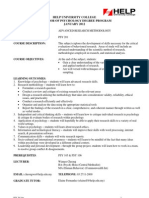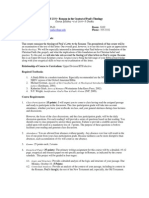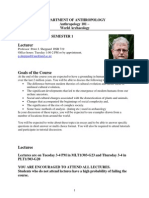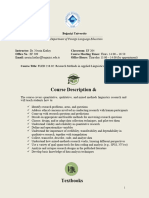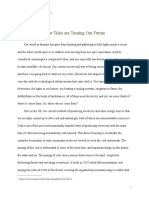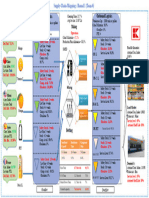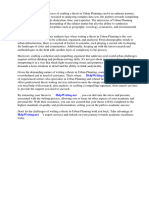Cell & Molecular Biology, BIOL 3450 SYLLABUS Fall 2014
Cell & Molecular Biology, BIOL 3450 SYLLABUS Fall 2014
Uploaded by
jkkmilkmanCopyright:
Available Formats
Cell & Molecular Biology, BIOL 3450 SYLLABUS Fall 2014
Cell & Molecular Biology, BIOL 3450 SYLLABUS Fall 2014
Uploaded by
jkkmilkmanOriginal Title
Copyright
Available Formats
Share this document
Did you find this document useful?
Is this content inappropriate?
Copyright:
Available Formats
Cell & Molecular Biology, BIOL 3450 SYLLABUS Fall 2014
Cell & Molecular Biology, BIOL 3450 SYLLABUS Fall 2014
Uploaded by
jkkmilkmanCopyright:
Available Formats
Cell & Molecular Biology, BIOL 3450 SYLLABUS Fall 2014
1
INSTRUCTORS:
Alfred Merrill, Ph.D. IBB Room 3309, 404-385-2842 al.merrill@biology.gatech.edu
Fredrik Vannberg, Ph.D. Boggs 1-94, 404-385-3480 fredrik.vannberg@biology.gatech.edu
Teaching assistant: Kasahun Neselu Gtbiology3450@gmail.com
COURSE HOURS/LOCATION: MWF 10:05-10:55 am/ Boggs B6
OFFICE HOURS: No regular office hours are scheduled, but students are STRONGLY ENCOURAGED to meet with the
TA and instructors when needed by arranging a time via e-mail.
COURSE DESCRIPTION: Modern cell biology is a unifying discipline that describes the structure and function of cells
in all their genetic, biochemical, developmental, physiological and pathophysiological aspects. This course will introduce
students to the dynamic relationships between cell structure and the biochemical reactions that are necessary for cell growth,
differentiation, survival and death with an emphasis on eukaryotic cells. The format of the course will consist of class
lectures (which primarily draw on information found in the textbook), in-class discussion of topics related to the lecture
material, and analysis of assigned research articles, with each student preparing a WRITTEN SYNOPSIS/CRITIQUE
of one research paper (or, for a few volunteers, prepare an ORAL PRESENTATION as part of a small teamsee
description of this later in the syllabus). It is estimated that 1-2 hours will be required outside of class to prepare for EACH
lecture, although some students might need to commit more time, and each research paper will require additional hours of
study/preparation.
TEXTBOOK: H. Lodish et al. 2012. Molecular Cell Biology, 7th Ed. W.H Freeman and Company, and Turning Point
transmitter. Optional reading (on reserve in the library): Gillen, C. M., 2007. Reading Primary Literature,
Pearson/Benjamin Cummings Pub. (ISBN-13: 978-08053-4599-5).
OTHER SOURCES: The website for the textbook; Biomedical search tools: PubMed (and Google Scholar)
http://www.ncbi.nlm.nih.gov/pubmed/. Online journals via the Georgia Tech library: http://sfx.galib.uga.edu/sfx_git1/az
(and link Citation Linker on that web site). Link to useful online cell biology resource: http://www.cellbio.com
DOWNLOAD THIS PAPER VIA GEORGIA TECH LIBRARY EJOURNALS: Ex vivo culture of circulating breast
tumor cells for individualized testing of drug susceptibility, Min Yu et al., Science 345, 216 (2014); DOI:
10.1126/science.1253533
COMPLEMENTERY CELL BIOLOGY LEARNING EXPERIENCES: Occasional discussions and internet exercises
that explore and expand cell biology concepts and practice will be held outside of class. These are not required, nor provide
bonus credit, but some students might find that this helps them learn the material. The dates, times and meeting places will
be announced during the semester. The instructors will explore if the use of Turning Point clickers will facilitate the
discussion.
CLASS CONTACTS: We strongly suggest that you get to know at least a few other students in the class so you can help
each other with questions, studying, etc.
IMPORTANT GEORGIA TECH DATES
Mon Aug 18 CLASSES BEGIN
Mon Sept 1 OFFICIAL SCHOOL HOLIDAY
Fri Oct 11 Last day to withdraw from individual courses with a grade of "W"
Sat-Tues Oct 11-14 FALL BREAK
Thur-Fri Nov 27-28 Thanksgiving Break
Fri Dec 5 LAST DAY OF CLASSES
Mon Fri Dec 8-12 FINALS WEEK
IMPORTANT COURSE DATES
Wed Sept 10 EXAM 1
Wed Oct. 1 EXAM 2
Wed Oct. 29 EXAM 3
Mon Nov 24 EXAM 4
FRI Dec. 12 FINAL EXAM (CUMULATIVE); 11:30am - 2:20pm
Cell & Molecular Biology, BIOL 3450 SYLLABUS Fall 2014
2
EVALUATION CRITERIA:
Lecture exams: 60% of the final grade (300 points total). There will be FOUR closed-book exams during the
semester. Each will consist of multiple-choice and short answer questions. Your lowest score will be dropped,
so each of the remaining exams is worth 20% of the final grade. If you are participating in an excused activity
(scientific conference, sports event, etc.) that causes you to miss an exam, the instructors will try to schedule for
you to take it early, but you must arrange when (which is usually the day before the scheduled exam date) at
least two weeks before the scheduled exam date. If it is not possible to schedule a time for you to take the exam
early (or you elect not to do so), the one you miss will be counted as the dropped exam.
NO Makeup exams will be given so try to take all exams in case you miss one due to illness or
another unexpected interruption. If you have a more prolonged illness (or several) that cause you to
miss more than one exam, you should contact the Dean of Students office to certify the illness(es) and
the Dean will inform us that some sort of accommodation would be appropriate.
IF YOU HAVE A COLD or OTHER MINOR, POTENTIALLY COMMUNICATIBLE ILLNESS
DURING AN EXAM OR OTHER CLASS WHEN ATTENDANCE IS REQUIRED: Please let the
teachers know so they can try to find a way for you to participate far enough away from other students
to minimize its spread (for example, in the hallway). If you are seriously ill, do not come to class.
Final exam: 20% of the final grade (100 points total). THE FINAL EXAM is an integrative overview of all
of the cell biology concepts covered in the course (not just the chapters since exam 4, but also the earlier
material). The final exam cannot be dropped.
Research paper analysis: 20% of the final grade (100 points total). This activity gives students experience in
reading and discussing primary, peer-reviewed research papers in molecular and cell biology to familiarize them
with how research in this area is conducted and reported. Four papers will be discussed in depth during the
semester, and each student will responsible for the aspects of the papers that are discussed in class (there will be
a few questions on the exams from this material) and preparing a WRITTEN report on ONE of the papers.
Early in the semester, the instructors will create a sign-up site on T-square where students can express their
preference for the paper that they will analyze for this report (each will have enough sign-up slots for
approximately 1/4 of the class, so if you have a strong preference for which paper you use for your written
report, sign up early).
The written report (15% of your final grade; 75 points) will be a 2-page summary of the paper
including an analysis/critique of some aspect of the paper. In general, the first half of the report will be similar
to the abstract of the paper but with additional background information, more specifics about the experiments
that were done, and key results. The second half of the paper will discuss some aspect of the paper that the
student considers to need improvement (for examples: Was one of the methods used incorrectly? Did the authors
misinterpret the data in a figure or table? Did the authors overlook an important paper already in the literature
that would have affected their conclusions?), or if the work is judged to be solid, a discussion of how the
findings might be built on by follow-up experiments. These students are expected to provide documentation for
their comments on all aspects of the paper (background, key methods, discussion of the results, etc.) by citing
pertinent papers from the scientific literature (and putting these in a bibliography with at least 5-6
references from the peer-reviewed research literature). The grading rubric that is used by the instructors will be
posted on T-square so students should take care to include information in all of the categories that are scored.
The report must be turned in at the beginning of the class that it is due; if late, the score will be reduced 10
points (one letter grade) per day it is late.
The in-class discussion (5% of your final grade; 25 points) of the papers will follow this general
outline: a) the instructors will distribute a list of the major issues/questions about the paper that they want the
class to notice and discuss; b) there will be a 15-minute overview of the main points in the paper to orient
everyone to it; c) approximately 15 min will be allocated for students to use the understanding that they have
gotten about the paper from this overview plus the paper itself to arrive at answers for the major issues/questions
provided by the instructors; and d) the last 15 min of the class will be used for discussion of these
Cell & Molecular Biology, BIOL 3450 SYLLABUS Fall 2014
3
issues/questions. After this discussion, the students will hand in the bottom section of the list distributed by the
instructor as a record of participation; student feedback on the paper will also be collected via this document
and/or clicker responses. Since there are 5 papers, each will be worth 5 points (1% of the final grade). If you
are absent for a paper discussion, there will be an opportunity to make up the points under the extra credit
opportunities explained later in the syllabus).
Student volunteers for the 15-minute overview of the paper: The overviews of the papers at the
beginning of the class discussions are usually more interesting when given by small teams of students who
volunteer to do this (if none volunteer for a particular paper, the instructors will introduce the paper). One
advantage for students who participate in the in-class overview is that they do not need to submit a 2-page
written review; however, the preparation usually takes the same effort (and sometimes morealthough students
who invest this time usually report that it was worth it). Some more details about how to present the paper are
given below. If you are interested in doing this, we recommend that you form your team (6 to 8 students, max)
and contact the instructors stating that you would like to give the overview as soon as possible after the papers
are posted. If more than one team volunteers, we will correspond with the team leaders (i.e., the person(s) who
initiate the contact with us) to try to ascertain who might do the better job, since this presentation is important
for the entire class. In the event of a tie, the group will be selected randomly.
Organization of the in-class overview of the research papers: The team that prepares the overview for
presentation in class should use PowerPoint to summarize the background, hypothesis, methods, results, and
discussion of the paper. The first page of the ppt file for the presentation should give the name of the paper (title,
authors, journal, etc.), and the names of all of the students in the group. It should also have a statement that:
The preparers of this presentation agree that it can be posted on t-square for use by other students in the
class only. None of the material may be reproduced or used for other purposes because it may be covered
under copyrights from the original sources. Next, there should be 2 to 3 slides summarizing the background
for this paper and its hypothesis, 2-3 slides explaining key methods; 4-5 slides showing key data; 1-2 slides
summarizing the conclusions; 1-2 slides stating some concerns and directions for future work; and a
bibliography of at least 5 research papers used in analysis of this paper and the points you have raised
(additional references to web sites and other information sources can be added, but the bibliography must
contain 5 references from research journals). Be careful to include only the most essential points in each slide
since the entire presentation must be made in 15 minutes. A copy of the grading template is posed on T-square
so students will know what is considered to be most important for them to cover. A single grade will be
assigned for the entire group, so the group should prepare and rehearse it early (in the rare event that a member
of a group is having difficulty with his/her portion of the presentation, and the others need to help). The
instructors hope the teams will consult them during the preparation of the overview, and show them a draft of
the Powerpoint presentation. The instructors are willing to make suggestions for improvement of the
presentation, but to ensure that they have time to do so, you need to contact them well in advance of the
presentation date.
Extra credit opportunities: There are several ways that students can contribute to the course and when these are
done, the points are recorded as extra crediti.e., the points are added to the sum for the semester. A
maximum of 15 points can be earned using the options below (which is equivalent to adding 15 points to a
single exam score, or 3 points to the final grade average). You may continue to participate in the discussions
beyond this, but you will not receive extra credit for the participation (the only exception is where you can use
points to offset points you lost because you missed one or more in-class discussion of a research papersee
discussion of these points at the end of this section).
1) Participation in organized in-class discussions or a spontaneous discussion: As often as possible,
the instructors will supplement the lectures with discussions of topics related to the course material. One
example that will be used throughout the semester will be to use the research paper Ex vivo culture of
circulating breast tumor cells for individualized testing of drug susceptibility (Min Yu et al., Science 345, 216
(2014); DOI: 10.1126/science.1253533) to illustrate how the information in this course will enable you to
understand new discoveries as they occur.
If feasible, some of the discussions will be conducted as clicker exercises. Whether the discussions
are conducted with or without the use of clickers, the goal will be to help students relate to the information
Cell & Molecular Biology, BIOL 3450 SYLLABUS Fall 2014
4
presented in class as active participants rather than just listeners, and to give the instructors feed-back on
whether the learning objectives are being accomplished. Typically, the instructor will present a series of
questions or problems related to the topics covered in class; students will formulate possible answers/solutions,
which will then be discussed orally and/or by clicker feedback. There will be no make up opportunities for
these in-class activities, but if a clicker devise is used and you do not have one (or it is malfunctioning), you will
be able to fill in a form in class that lets the TA know that you have participated.
In addition to these discussions that are initiated by the professors, students may contribute to the
effectiveness of the class by bringing in an outside connection, asking a particularly thoughtful question that
adds to the learning experience for the class, etc.
If you participate in these ways, you will be awarded 1 point per participation (keep in mind that your
total extra credit points for the semester can only sum to 15 points) if you notify the TA of your participation
ON THE SAME DAY as it occurs. If you forget, we cannot award these points to you later in the semester
because we will not remember if you actually participated.
To inform the TA of your participation, fill-in in class (or e-mail on the same day) the following
information (this can also be downloaded from T-square as the I participated form):
Student name: Date:
I participated in todays class in the following manner: (fill in with enough information for the
instructor to remember what you did and recognize that you deserve acknowledgement for this participation).
If we agree that your participation qualified for the point, it will appear in the gradebook on T-square
within approximately one week from when it is earned.
2) Attending the Festival of Research Ideas in Cancer Biology and Technology on November 20
from 5 to 7 pm. This event will be held in the atrium of the IBB and you will be given instructions about what is
needed to qualify for extra credit near the date of this event (this is usually worth 2 to 3 points).
3) Near the end of the semester, if >60% of the class performs the on-line course critique, everyone in
the class will receive 1 point; if >80% reply, everyone will earn 2 extra credit points; if >90% reply, everyone
will receive 3 extra credit points.
4) The instructors might add a few other extra credit opportunities, such as to attend and report on
a major conference or seminar at Tech related to class, etc. If these become available, they will be posted as
announcements on T-square.
Comment about the use of extra credit to make up for missed in-class participation: If you miss an
in-class discussion of a research paper (each of which is worth 5 points), 5 points of extra credit points can be
used to offset this deficiency. These do not count against the total of 15 points of extra credit that you can earn,
so if you earn 20 points of extra credit, 5 could be used to offset the missed in-class participation and the other
15 would remain extra credit points.
CALCULATION OF FINAL GRADE:
Your average for the course is calculated as follows:
Sum of the scores on 3 of the 4 lecture examsi.e., having dropped the lowest lecture exam score
(max number of points = 3 x 100)
+
Score on the final exam (max number of points = 1 x 100)
+
Cell & Molecular Biology, BIOL 3450 SYLLABUS Fall 2014
5
Sum of scores from the paper analysis (75 pts max) and participation in in-class discussions of the research
papers (25 points) (max number of total points = 100)
+
Sum of extra credit points (max 15 points)
The sum of the above (max # of points = 500 + extra credit)/5 = score used to compute final grade.
The letter grade is assigned by the scale: A= >90; B= >80, C= >70, D= >60, F= <60. Grades are not curved,
but fractions are rounded to the nearest number (e.g., 79.6 -> 80).
Comment about not curving the grades: the instructors examine the class responses to each question of each
exam and if we discover that performance was lower than expected on a given question due to deficiencies in
the design of the question, we adjust the points immediately and inform the class when the exam grades are
posted.
If you disagree with the points that have been awarded to you on an exam or your written report: you
should report this to the TA within a week after you have received the grade to determine if the error was merely
a miscalculation. If you disagree with the number of points that have been awarded by the TA, you should
contact the instructor who prepared the question (or assigned the paper) within two weeks (thus, you have one
week to check with the TA first, then another week to consult the professor, if you deem necessary). You are
welcome to do this, however, you should examine your answers carefully first. TAs sometimes give more
points for an answer than the instructor would, so review of your answers by the instructor might reduce your
grade rather than increase it, if your argument for why your grade should be higher is not strong.
POLICY REGARDING LAPTOP, TABLET and SMARTPHONE USE IN CLASS: Students are welcome
to bring such devices to class to use for note taking, looking up related information on the internet, etc. Indeed,
we encourage students to look up related topics on Pub Med or another scientific search engine if hearing about
a topic in class stimulates interest in learning more about it than is covered in class.
HOWEVER, THESE DEVICES MAY NOT BE USED DURING CLASS TO SEARCH
INFORMATION NOT RELATED TO THE CLASS (Facebook, etc.)This regulation will be enforced by the
TA (who sits at the back so the content on screens can be seen), possibly resulting in a subtraction of points
from the in-class-participation grade. This rule is important because screen images that are unrelated to the
course content are often distracting to other students.
The instructors realize that there might be special instances where you need to receive an important
message during class. If this applies, sit on the last row of the classroom so your activities will not distracting to
other students.
Other important comments related to this course. This course is taught at a 3000 leveli.e., it is assumed
that the students who take it have decided that the course content is important for their lives and career, and not
merely a class that they have to take to fulfill a requirement for graduation. It covers a lot of information that
will be valuable to you if you get a job that deals with molecular cell biology or pursue additional post-graduate
research or clinical training, and we hope you will someday let us know if you agree or disagree with this
assessment (so far, the cards and e-mails weve gotten from former students have agreed!).
Students sometimes earn a lower grade than they think they should because they take this course before
they are prepared, or with a too-heavy load of other courses, or due to other complications. We hope this will
not be the case for you, and we have provided suggestions (below) that might help you study for the exams.
However, if you do poorly, remember that learning how to deal with adversity is one of the keys to success in
life. You might be surprised by how often successful scientists and engineers can recount instances where they
performed poorly in a course the first time they took it and this led them to retake the same or related material to
make up for this weakness, resulting in their becoming strongest on that subject. Although it is unusual to take a
course twice, a few students have done so for BIOL3450 and found it to be worthwhile.
Cell & Molecular Biology, BIOL 3450 SYLLABUS Fall 2014
6
Suggestions for studying: Here are suggestions from three sources about how best to learn the material
in this course.
I. General principles/approaches:
a) Take notes by hand. Rewrite your notes, preferably no later than the evening of the class day. Do not
just recopy your notes, but rather both condense and extend them where appropriate, paraphrasing them so that
you make the meaning your own.
b) Develop relationships with other class members and form study groups if you can, so you can
convert the information from a passive mode into an active mode, as you discuss it with others.
c) Work what if scenarios and practice problems: study the text and lecture information, then ask
yourself (and/or study team members) questions about it to ensure you really know it. If there are mathematical
relationships, think of practice problems using them.
d) Enter the testers mind by asking yourself (or team members) what are the most important things in
each section, keeping in mind both that you need to know the concepts involved and the appropriate vocabulary
to describe the process. You can take the exams from previous semesters to see if your level of questioning is
similar to the instructors, but do not study the exams because most of the questions are made fresh every
semester.
e) Set attainable study/learning goals so the time you allocate to studying this course is used most
effectively. For examples: If you learn best from the notes with supplementation from the textbook, do not read
the textbook first and end up using all your study time getting halfway through the chapter and having none left
to review the notes. If you start your review by recopying the diagrams in the notes from memory, do not get
bogged down in trying to exactly recapitulate the artwork when a simpler sketch will describe the main ideas
adequately.
II. Learning suggestions from Dr. Merrill: As you study the material, ask yourself:
1) What fundamental cell biology question is this addressing? For example: How do proteins
get from their site(s) of synthesis to their ultimate destination(s) in cells?
2) Then, imagine that you have been asked this question by someone you know, and you are
answering it for them.
3) and they keep asking you for clarification--Okay, but how does that work? How does
the cell turn that on and off? What happens after that? What use is that?
4) Repeat this exercise until you think you have been able to explain how the process works
using the appropriate terms that apply to the steps you have had to explain. You will retain this vocabulary of
new terms and concepts longer than if you try to memorize them as items on a page.
III. Comments/suggestions from previous students who have done very well on the exams:
>I have learned to focus heavily on the lecture slides, and to completely understand every word and
mechanism discussed in these slides. As I go through the lecture slides, I look at the corresponding book
material, focusing only on the picture captions for diagrams discussed in class and the text descriptions of the
complex mechanisms. Thus, I refer to the book more as a secondary reference to clear up material that I find
confusing from lecture. I find the section summaries in the textbook to be very helpful for understanding big
concepts as well. I also look through all the old practice exams and make sure to not only understand what the
correct answer is and why, but also why the other answer choices are wrong. I have found these methods of
studying to help me on past exams, and I hope they can be of some assistance to other students.
>I hear people say Biology is all about memorization, but I completely disagree. In fact, I can't
memorize anything I don't understand. I believe they should do the same, i.e. understand all the concepts before
resorting to memory.
>It's always helpful for me to read the book, before or after class. It helps keep what you're learning on
track and in a way put it all in better context. [this is only true, however, if you can read fast enough to keep up
with the class; otherwise, it can make you get behind]
>A studying technique that's been VITAL for me: Here's how I studied for the last test. I went to the
Molecular Science and Engr. Bldg, picked an empty classroom and started lecturing!! Granted I sounded crazy
for being alone in there and talking to myself for hours, but it was an extremely beneficial experience for me. (1)
It prevented me from getting bored as opposed to when sitting and studying on some desk. (2) It allowed me to
Cell & Molecular Biology, BIOL 3450 SYLLABUS Fall 2014
7
realize how much I do or don't know about a concept and act accordingly. (3) If you really convince yourself
that you're in a real classroom, it would allow you to think like a teacher, elaborate on concepts, and be better
prepared for the test.
>To do well in Cell Bio in general, after studying I'd take the old tests posted on T-square and make
sure I know how to answer the questions, not remember the answers.
>My advice to other students would be to look over the parts of the book that were covered in the
powerpoints, especially if they don't understand the pictures/figures. I also tend to jot down a few notes when
reading over sections of the book just to make sure that I understand the concept.
>The method that I have found most helpful when studying has been to teach the material to another
person, while using the slides and my notes as prompts. Obviously, it's best to have studied some before doing
this, so that it's not just reading off the slides. I find this to be more interesting than staring at the pages for hours
and involving another person adds motivation and focus, since it is embarrassing to fumble with the information
in front of someone else. Additionally, being asked questions by a motivated listener really helps me pick out
which areas I need to work on. For me, this is the best method, particularly because I am interested in becoming
a professor, but it can be time consuming. Generally, I would recommend small study groups, since it is easier
to ask questions and be involved. Removing the answers from the old exams before looking at them and waiting
until after studying to attempt the old exams are also helpful because it is easier to identify what has been
effectively learned and which topics need to be reviewed.
These suggestions are provided as food for thought and we hope you have, or are successful in
developing, method(s) that work well for you. Feel free to discuss this with the instructors if you are having
difficulty learning the material and doing well on the exams.
Stress management: We find that some students have difficulty with stress while taking this course,
with a lot of factors coming into play: it covers a lot of material; the students who take it come from a variety of
backgrounds; many of the students have a heavy load of other courses and outside activities that compete for
their time; andbeing a 3000-level course--the format is more open-ended than most (or all) of the courses
that the students have taken previously. By open-ended we mean that the goal of the course is not just to
survey the major concepts and processes in cells at a molecular and cellular levels, but also to prepare students
for future developments in the field by discussing recent research publications and broader implications of the
subject.
The first way to control stress about the course is to keep up-to-date with the course material, being
careful to prioritize your time in dealing with it. Most students find the class ppt and notes to be the best place
to start, then use the textbook to further explain topics that you do not understand from the notes, as well as to
read about topics that were not covered but interest you. If, however, you are the type of student that learns best
from the textbook, feel free to use your preferred method to learn the material, but notice which topics are
emphasized by the instructors (by what they covered in class--you do not need to learn everything in the
textbook, so do not let it scare you). We think you will find it useful to study with others; however, this doesnt
work for everyone, and you can be just as successful at learning the material by teaching it to an imaginary
friend as long as she/he is able to ask questions about it to ensure you know what you are talking about! See
the section above about study methods, if you think it might also help.
The Counseling Center is committed to helping Georgia Tech students manage their stress so that they
can succeed. They have a variety of brochures and programs devoted to this important skill of stress
management. You can get them by going by the counseling center to pick up a brochure or you can download it
from their web site, which also has videos on stress and strategies for dealing with stress:
http://www.counseling.gatech.edu/plugins/content/index.php?id=32
Some students also benefit from assistance from the Georgia Tech ADAPTS office, and if you think
they can be helpful, we encourage you to contact them (http://www.adapts.gatech.edu).
Cell & Molecular Biology, BIOL 3450 SYLLABUS Fall 2014
8
Sometimes students have difficulty taking an exam when uncomfortably crowded between other
students, so if that happens to you, feel free to move to another seat in the room (there are usually several at the
front), and weve occasionally had students take the exam in the hallway.
THE HONOR CODE AT GEORGIA TECH: All students are required to adhere to the Georgia
Tech Academic Honor Code (www.honor.gatech.edu). This includes, but is not limited to, the following issues
that pertain to the oral and written critiques, mnemonic tools, and exams for this class:
1. Plagiarism is not allowed. Plagiarizing is defined by Websters as to steal and pass off (the ideas or words of
another) as one's own; use (another's production) without crediting the source.
In simpler terms: When you use any phases, sentences, etc. verbatim from another source, they must be
identified by quotation marks and citation of the source. In scientific writing, it is generally preferable to
rephrase information from other sources and cite the source rather than use the same text, even when you offset
the text with quotation marks. When you show diagrams, models and other materials that are not your own, the
sources must also be identified.
In science, it is assumed that most of what you write or say has come from another source, even if you are
assembling the information into a hypothesis or conclusion that is uniquely your own. Therefore, you are
expected to acknowledge those sources. These rules apply both to published information and information that
you might receive from another student, website, previous class report, etc.
Plagiarization will be dealt with according to the GT Academic Honor Code.
2. Students are encouraged to collaborate in some aspects of the preparation of oral and written critiques, such as
the early stages where you are achieving an understanding of the assigned papers; however, the final critiques
must be written by each student alone.
For team oral presentations, students may collaborate in all aspects of the work, indeed, it is expected
that all will contribute equally to the final product and that they will share the single grade that is awarded for
the ppt presentation. Students may use copyrighted figures, etc. from publications in the ppt presentation if
appropriate citations are given because the ppt will only be posted on access restricted WebCt website. However,
if the team uses multiple copies of any copyrighted items (such as the pdf file of a copyrighted article), each
student shown download their own copy from the Georgia Tech library website rather than for one student to
distribute the pdf.
In the event an assigned paper has been used by a previous class, students are not allowed to use any of
the ppt slides in whole or part that were prepared by the other class.
3. Unless specifically identified as group work; quizzes, tests, takehome-tests, homework, etc. are to be
completed alone.
4. For Quizzes/Tests: Cheating off of another persons test or quiz is unethical and unacceptable.
Cheating off of anyone elses work is a direct violation of the GT Academic Honor Code, and will be dealt with
accordingly.
5. Because the exams for this course change every semester, students may use old tests as study tools.
For any questions involving these or any other Academic Honor Code issues, please consult the professors,
teaching assistant, or www.honor.gatech.edu.
Cell & Molecular Biology, BIOL 3450 SYLLABUS Fall 2014
9
Class # DAY DATE Chap LECTURE TOPIC Lecturer
1 MON 18-Aug 1 Introduction to cells and cell biology literature AM
2 WED 20-Aug 2 Chemical Foundations AM
3 FRI 22-Aug 2,3 Chemical Foundations & Protein Structure and Function AM
4 MON 25-Aug 3 Protein Structure and Function AM
5 WED 27-Aug 4 Basic Molecular Genetic Mechanisms FV
6 FRI 29-Aug 5 Molecular Genetic Techniques FV
MON 1-Sept OFFICIAL SCHOOL HOLIDAY
7 WED 3-Sept 5 Molecular Genetic Techniques FV
8 FRI 5-Sept 6 Genes, Genomics and Chromosomes FV
9 MON 8-Sept 7 Transcriptional Control of Gene Expression FV
10 WED 10-Sept EXAM 1 (Chap. 1-6) AM/FV
11 FRI 12-Sept 7 Transcriptional Control of Gene Expression FV
12 MON 15-Sept 8 Post-transcriptional Gene Control FV
13 WED 17-Sept 10 Biomembranes AM
14 FRI 19-Sept 11 Transport of ions & small molecules AM
15 MON 22-Sept 12 Cell energetics AM
16 WED 24-Sept 13 Moving Proteins into Membranes and Organelles AM
17 FRI 26-Sept 13,14 Vesicular Traffic, Secretion, and Endocytosis AM
18 MON 29-Sept 14 Vesicular Traffic, Secretion, and Endocytosis AM
19 WED 1-Oct EXAM 2 (Chap. 7-9,11-14) AM/FV
20 FRI 3-Oct 15 Signaling I AM
21 MON 6-Oct 15, 16 Signaling I and II AM
22 WED 8-Oct 10* Techniques used in cell biology KN
23 FRI 10-Oct 10* Techniques (continued) (*Yu et al., Science, 2014) KN
10-Oct Last day to drop individual courses(s) with a grade of "W"
MON 11-14-Oct FALL BREAK
24 WED 15-Oct FIRST PAPER DISCUSSION FV
25 FRI 17-Oct SECOND PAPER DISCUSSION FV
26 MON 20-Oct 16 Signaling II
27 WED 22-Oct 17 Microfilaments AM
28 FRI 24-Oct 17,18 Microfilaments & Microtubules AM
29 MON 27-Oct 18 Microtubules & IF AM
30 WED 29-Oct EXAM 3 (Chap. 10,15-18, 1
st
and 2nd Papers) FV/AM
31 FRI 31-Oct 20 Integrating Cells into Tissues AM
1,2-Nov GT Homecoming
32 MON 3-Nov 19 Eukaryotic Cell Cycle FV
33 WED 5-Nov 19 Eukaryotic Cell Cycle FV
34 FRI 7-Nov 21 Stem Cells, Cell Asymmetry & Cell Death FV
35 MON 10-Nov 21 Stem Cells, Cell Asymmetry & Cell Death FV
36 WED 12-Nov 22 Nerve Cells FV
37 FRI 14-Nov THIRD PAPER DISCUSSION AM
38 MON 17-Nov FOURTH PAPER DISCUSSION AM
39 WED 19-Nov 23 Immune cells FV
40 FRI 21-Nov 23 Immune cells FV
41 MON 24-Nov EXAM 4 (Chap. 19-23 & 3
rd
and 4
th
Papers) FV/AM
42 WED 26-Nov 24 Cancer AM
FRI 27-28-Nov THANKSGIVING HOLIDAY
43 MON 1-Dec 24 Cancer AM
44 WED 3-Dec 24 Cancer AM
45 FRI 5-Dec Course Wrap-up AM/FV
FRI 12-Dec FINAL EXAM (11:30am - 2:20pm)
Chap. 24 and the entire semester
You might also like
- 2021S JEG100H1 Finkelstein Syllabus 20210107Document9 pages2021S JEG100H1 Finkelstein Syllabus 20210107Ada LovelaceNo ratings yet
- Electronic Principles and Circuits Lab Manual - BEC303 - 18-11-2023Document69 pagesElectronic Principles and Circuits Lab Manual - BEC303 - 18-11-2023Maithira H50% (2)
- BLG 230 SyllabusDocument6 pagesBLG 230 Syllabusjulliee112No ratings yet
- BARK BCHS3304 Syllabus Fall 2014Document7 pagesBARK BCHS3304 Syllabus Fall 2014ntowl24No ratings yet
- Biol 3103 Syllabus and Schedule SP 19Document11 pagesBiol 3103 Syllabus and Schedule SP 19api-263358650No ratings yet
- SyllabusDocument4 pagesSyllabus陈杰No ratings yet
- Biol 1361 Syllabus f15 Mw-3Document9 pagesBiol 1361 Syllabus f15 Mw-3Christine NguyenNo ratings yet
- Playwright's Primer - Updated PuppeteerDocument8 pagesPlaywright's Primer - Updated PuppeteerDamian Fitzpatrick100% (1)
- Syllabus Cell Biology (BIO 3000) : InstructorDocument7 pagesSyllabus Cell Biology (BIO 3000) : InstructorMary JewelNo ratings yet
- Plant Ecophysiology - BIOL 255: Course Outline 2011Document5 pagesPlant Ecophysiology - BIOL 255: Course Outline 2011biodaviNo ratings yet
- Bio312 Fa2015 Carter SyllabusDocument5 pagesBio312 Fa2015 Carter SyllabusAnonymous bZTdTpLNo ratings yet
- BIOC65 Syllabus 2012Document2 pagesBIOC65 Syllabus 2012LianneNo ratings yet
- Biology 1 Lab Manual 201405Document116 pagesBiology 1 Lab Manual 201405Krishnaah SmuglerzzNo ratings yet
- Cell Biology (Bio 308) : Instructor: Ted Wilson, PHDDocument3 pagesCell Biology (Bio 308) : Instructor: Ted Wilson, PHDarunNo ratings yet
- Genetics SyllabusDocument125 pagesGenetics SyllabusHoangTuan LyNo ratings yet
- CHE353 Course Details 2015Document3 pagesCHE353 Course Details 2015Sourabh DasNo ratings yet
- BIOO 433.01 - Plant PhysiologyDocument5 pagesBIOO 433.01 - Plant Physiologyasmeraamde21No ratings yet
- Biol 3030-002Document11 pagesBiol 3030-002Manju PushkasNo ratings yet
- Pate Bio180 Lecture Syllabus - Spring 2016Document5 pagesPate Bio180 Lecture Syllabus - Spring 2016samNo ratings yet
- Spring 10Document4 pagesSpring 10Theodore LiwonganNo ratings yet
- BIOO 433.01 - Plant PhysiologyDocument5 pagesBIOO 433.01 - Plant Physiologyasmeraamde21No ratings yet
- Cell Biology LabManual Version 8.0 May 2012 1 TRUNCATEDDocument57 pagesCell Biology LabManual Version 8.0 May 2012 1 TRUNCATEDதுர்காஸ்ரீ கங்கா ராதிகாNo ratings yet
- Anhb1101 2016 Sem-1Document5 pagesAnhb1101 2016 Sem-1DoonkieNo ratings yet
- Introduction To Survey Research: PS 544, SOC 544, JOURN 544, URB R PL 544 Spring 2014Document7 pagesIntroduction To Survey Research: PS 544, SOC 544, JOURN 544, URB R PL 544 Spring 2014Kyal De WetNo ratings yet
- 9-28-11 Syllabus-Bio97 DAB Version 8Document6 pages9-28-11 Syllabus-Bio97 DAB Version 8kevinv263No ratings yet
- Bio111 2015spring Minckley 1 - 111policylec15full 6Document5 pagesBio111 2015spring Minckley 1 - 111policylec15full 6api-283084607No ratings yet
- MLS 610 Biomedical Laboratory Management Fall 2012: E-Mail: Barry - Corriveau@uhn - EduDocument9 pagesMLS 610 Biomedical Laboratory Management Fall 2012: E-Mail: Barry - Corriveau@uhn - EduZak AhmadNo ratings yet
- Aneuroscience 11112013 SYLLABUSDocument3 pagesAneuroscience 11112013 SYLLABUSrohitNo ratings yet
- Theories of Crime Causation SyallbusDocument11 pagesTheories of Crime Causation SyallbusCompuesto JassonNo ratings yet
- 270 Syllabus Autumn 2016Document15 pages270 Syllabus Autumn 2016S. M. Hasan ZidnyNo ratings yet
- COURSE SYLLABUS Vert. Zoology Spring 2021-1Document4 pagesCOURSE SYLLABUS Vert. Zoology Spring 2021-1Jinn Allan LuañaNo ratings yet
- Coursesyllabusartic 14 FallDocument6 pagesCoursesyllabusartic 14 Fallapi-316478659No ratings yet
- 2010 PHIL252 1 SyllabusDocument16 pages2010 PHIL252 1 SyllabusEMka Anwar MaulanaNo ratings yet
- Course OutlineDocument7 pagesCourse OutlineHabib A IslamNo ratings yet
- Psychology 219 Syllabus Spring 2018Document4 pagesPsychology 219 Syllabus Spring 2018Nick WeberNo ratings yet
- Chudalla@lpge.k12.mn - Us: Ap Biology Long Prairie/ Grey Eagle High School 2014-15Document17 pagesChudalla@lpge.k12.mn - Us: Ap Biology Long Prairie/ Grey Eagle High School 2014-15kawarriorNo ratings yet
- Geog 102Document4 pagesGeog 102Hay GoNo ratings yet
- Principles of Organismal Biology, Evolution & Ecology: Biosci 131-2743 Diablo Valley College - Fall Semester 2019Document8 pagesPrinciples of Organismal Biology, Evolution & Ecology: Biosci 131-2743 Diablo Valley College - Fall Semester 2019foreverinparadiseNo ratings yet
- Neurosci217_SyllabusSpring2025Document5 pagesNeurosci217_SyllabusSpring2025Sophie LiNo ratings yet
- Jan 2012 PSY 201 Course OutlineDocument10 pagesJan 2012 PSY 201 Course OutlineNottheReal KimNo ratings yet
- Physics For Scientists and Engineers Ii: Megha Agarwal, Wenbassign: Doug BairdDocument3 pagesPhysics For Scientists and Engineers Ii: Megha Agarwal, Wenbassign: Doug BairdejazNo ratings yet
- CHM 2211 Spring2013 Syllabus-FIELDSDocument7 pagesCHM 2211 Spring2013 Syllabus-FIELDSMathew FreemanNo ratings yet
- BABS1201 Summer 2015-16 ManualDocument157 pagesBABS1201 Summer 2015-16 ManualHi ByeNo ratings yet
- BTH 2331 (Fall 10) SyllabusDocument6 pagesBTH 2331 (Fall 10) SyllabusMark 'n Michelle WeedmanNo ratings yet
- 153anth 1a 1 - 1442493392Document10 pages153anth 1a 1 - 1442493392william1230No ratings yet
- SPS 102A Fall 2024 Syllabus-3Document10 pagesSPS 102A Fall 2024 Syllabus-3oguztemelliNo ratings yet
- BISC 433 Syllabus Spring2024Document7 pagesBISC 433 Syllabus Spring2024sebastiantabor01No ratings yet
- 3130 KwakDocument9 pages3130 KwakKelvin LeeNo ratings yet
- Anth 110 Syllabus - 2014Document5 pagesAnth 110 Syllabus - 2014John Joseph CrandallNo ratings yet
- SyllabusDocument10 pagesSyllabusAlskdjlk AlkjlkjNo ratings yet
- Course Outline For HLTH 301, University of CanterburyDocument8 pagesCourse Outline For HLTH 301, University of CanterburyArin BasuNo ratings yet
- Principles of Child DevelopmentDocument14 pagesPrinciples of Child Developmentnad101No ratings yet
- ANTH 101 Course OutlineDocument12 pagesANTH 101 Course OutlineShantrelle PendigrastNo ratings yet
- FLED 218.02 Syllabus Revised 2Document7 pagesFLED 218.02 Syllabus Revised 2Alper EsenNo ratings yet
- Biol 226 F2021Document8 pagesBiol 226 F2021boubou.goupiaNo ratings yet
- Syllabus LS3 Spring 2015 FINALDocument3 pagesSyllabus LS3 Spring 2015 FINALHugh BangNo ratings yet
- Psy393h5s Lec0101Document6 pagesPsy393h5s Lec0101Daisy DeveraNo ratings yet
- 391syllabus - Spring 14Document3 pages391syllabus - Spring 14api-239915567No ratings yet
- Syllabus Fall 2016 Chem 153ADocument5 pagesSyllabus Fall 2016 Chem 153AGabby TanakaNo ratings yet
- Sch4u Course Outline 2015 (Dce PRSS)Document3 pagesSch4u Course Outline 2015 (Dce PRSS)api-237258561No ratings yet
- Final Genetics Syllabus ReferenceDocument8 pagesFinal Genetics Syllabus ReferenceLady EmeterioNo ratings yet
- PLC & AC Drive With Automatic & Manual Industrial Control - Online Engineering CoursesDocument1 pagePLC & AC Drive With Automatic & Manual Industrial Control - Online Engineering CoursesMohamed AlkharashyNo ratings yet
- Joseph, O. Module 1 RES6013Document3 pagesJoseph, O. Module 1 RES6013Osger JosephNo ratings yet
- Developing A Us Strategy For Dealing With ChinaDocument5 pagesDeveloping A Us Strategy For Dealing With ChinapptmnltNo ratings yet
- June 2023 SANTA MARTA MARINA AND BEACH FRONT PROPERTY THROUGH FASTBLOC BUILDING SYSTEMDocument14 pagesJune 2023 SANTA MARTA MARINA AND BEACH FRONT PROPERTY THROUGH FASTBLOC BUILDING SYSTEMLUZ MOSNo ratings yet
- Split_20241221_1608Document40 pagesSplit_20241221_1608ak222222222222252222522222No ratings yet
- Trademark Status - Citykite - AbandonedDocument2 pagesTrademark Status - Citykite - AbandonedTeam JeeProfessionalsNo ratings yet
- RadiationDocument28 pagesRadiationJohn TauloNo ratings yet
- Tidal Energy EssayDocument5 pagesTidal Energy EssayDessie AliNo ratings yet
- Drawing Harmonic FilterDocument1 pageDrawing Harmonic Filtercr4ck3rjackNo ratings yet
- 1998 HMMT Advanced Topics Event: Sin (Cos Cos Sin Sin Cos) Tan (Sec Sin Tan) + + + 3 3Document2 pages1998 HMMT Advanced Topics Event: Sin (Cos Cos Sin Sin Cos) Tan (Sec Sin Tan) + + + 3 3michaelwronaNo ratings yet
- 20240117_1897694_Uniarch【Datasheet】Uho-S2E 2MP Indoor Pan & Tilt Wi-Fi Camera V1.5_951154_575359_0Document4 pages20240117_1897694_Uniarch【Datasheet】Uho-S2E 2MP Indoor Pan & Tilt Wi-Fi Camera V1.5_951154_575359_0elabnodyNo ratings yet
- Iso 16112 2017Document12 pagesIso 16112 2017Thanhluan NguyenNo ratings yet
- Traffic Management Study-Sadashivnagar and Bellary RoadDocument56 pagesTraffic Management Study-Sadashivnagar and Bellary RoadkumarnramNo ratings yet
- Supply Chain Map-1Document1 pageSupply Chain Map-1deepak devassiaNo ratings yet
- Solar RevolutionDocument1 pageSolar Revolutionapi-708047609No ratings yet
- Theories of Personality Midterm ReviewerDocument7 pagesTheories of Personality Midterm ReviewerJem GuicoNo ratings yet
- FMB Firmware Errata v0 22Document7 pagesFMB Firmware Errata v0 22skodasuperbv6No ratings yet
- American Statistical Association, Taylor & Francis, Ltd. The American StatisticianDocument8 pagesAmerican Statistical Association, Taylor & Francis, Ltd. The American StatisticianbasdggwawggNo ratings yet
- Case Memo - Cracker's BarrelDocument5 pagesCase Memo - Cracker's BarrelGiovanna Uragano BarbatoNo ratings yet
- D038 Evs Co000 1091 - 00Document1 pageD038 Evs Co000 1091 - 00Mussarat BabasahebNo ratings yet
- Exquisite CorpseDocument4 pagesExquisite CorpseJack FreedmanNo ratings yet
- Major Stars 3 - Unit 4 - Lesson 1Document6 pagesMajor Stars 3 - Unit 4 - Lesson 1ngocanhdo2709No ratings yet
- Thesis Urban PlanningDocument7 pagesThesis Urban PlanningKate Campbell100% (2)
- Kuji - One Piece Memories - Otaku HouseDocument1 pageKuji - One Piece Memories - Otaku Housechee yap limNo ratings yet
- CthulhuTech Quick Start RulesDocument50 pagesCthulhuTech Quick Start RuleszjacobsNo ratings yet
- BEE III IL ספר תחזוקה באנגלית קומפלט 050807Document36 pagesBEE III IL ספר תחזוקה באנגלית קומפלט 050807Lior EisenfeldNo ratings yet
- Poems For KidsDocument24 pagesPoems For KidsAna MAnaNo ratings yet
- Quality Framework - Edward SallisDocument5 pagesQuality Framework - Edward SallisDeNo ratings yet


